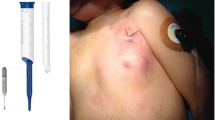Abstract
Background
Syncope and palpitations occur frequently in young patients. Noninvasive diagnostic testing may be inconclusive.
Aim
To assess the diagnostic yield of implantable loop recorders in young patients.
Patients and methods
Thirty-three young patients underwent implantation of a loop recorder for long-term monitoring of cardiac rhythm, to establish symptom–rhythm correlation. They belonged to one of three subgroups: those with structurally normal heart, normal electrocardiogram at rest, and negative family history (n = 16); patients with structural heart disease and previous surgical repair (n = 11), and patients with proven or suspected primary electrical disease (n = 6). A combination of automatic and patient-activated recordings was used to monitor cardiac rhythm during symptomatic episodes.
Results
There were no procedural complications. Diagnostic electrograms could be obtained in all patients. A high degree of symptom–rhythm correlation was established. In 8/33 patients, no recurrence of symptoms was observed either until end of battery life of the device (n = 4) or until last follow-up (n = 2). Specific cardiac therapy was required, based on rhythms recorded by the device in 15 patients (until last follow-up). This consisted of catheter ablation of a tachyarrhythmia (n = 7), pacemaker implantation or upgrade (n = 5) or ICD implantation (n = 5). In the remaining patients (n = 10), recurrence of symptoms was associated with a normal electrocardiogram, and in two of these patients a non-cardiac diagnosis was made.
Conclusions
In selected patients, the implantable loop recorder provides valuable diagnostic information to guide further therapy.
Similar content being viewed by others
References
Alexander ME, Walsh EP, Saul JP, Epstein MR, Triedman JK (1999) Value of programmed ventricular stimulation in patients with congenital heart disease. J Cardiovasc Electrophysiol 10:1033–1044
Ashby DT, Cehic DA, Disney PJ, Mahar LJ, Young GD (2002) A retrospective case study to assess the value of implantable loop recorder for the investigation of undiagnosed syncope. Pacing Clin Electrophysiol 25:1200–1205
Batra AS, Balaji S (2007) Does tilt table testing still have a role in the management of pediatric syncope? A survey of pediatric electrophysiologists. Heart Rhythm 4(abstract supplement):S262–S263
Gass M, Apitz C, Salehi-Gilani S, Ziemer G, Hofbeck M (2006) Use of implantable loop recorder in children and adolescents. Cardiol Young 16:572–578
Hoorntje TM, Langerak W, Sreeram N (1999) Munchausen’s syndrome by proxy identified with an implantable electrocardiographic recorder. N Engl J Med 341:1478–1479
Kammeraad JA, van Deurzen CH, Sreeram N et al (2004) Predictors of sudden cardiac death after mustard or senning repair for transposition of the great arteries. J Am Coll Cardiol 44:1095–1102
Khairy P, Landzberg MJ, Gatzoulis MA et al (2004) Value of programmed ventricular stimulation after tetralogy of Fallot repair: a multicenter study. Circulation 109:1994–2000
Krahn AD, Klein GJ, Yee R, Norris C (1998) Final results from a pilot study with an implantable loop recorder to determine the etiology of syncope in patients with negative noninvasive and invasive testing. Am J Cardiol 82:117–119
Krahn AD, Klein GJ, Yee R, Takle-Newhouse T, Norris C (1999) Use of an extended monitoring strategy in patients with problematic syncope. Reveal investig Circ 26:406–410
Rossano J, Bloemers B, Sreeram N, Seshadri B, Shah MJ (2003) Efficacy of implantable loop recorders in establishing symptom–rhythm correlation in young patients with syncope and palpitations. Pediatrics 112:e228–e233
Sanatani S, Peirone A, Chiu C, Human DG, Gross GJ, Hamilton RM (2002) Use of an implantable loop recorder in the evaluation of children with congenital heart disease. Am Heart J 143:366–372
Sreeram N, Hitchcock F, Bennink G (2005) Abdominal implantation of loop recorders in infants and children. Ann Thorac Surg 79:726–727
Author information
Authors and Affiliations
Corresponding author
Rights and permissions
About this article
Cite this article
Sreeram, N., Gass, M., Apitz, C. et al. The diagnostic yield from implantable loop recorders in children and young adults. Clin Res Cardiol 97, 327–333 (2008). https://doi.org/10.1007/s00392-007-0635-4
Received:
Accepted:
Published:
Issue Date:
DOI: https://doi.org/10.1007/s00392-007-0635-4




